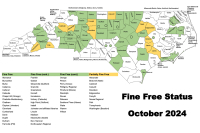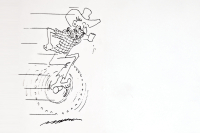George R.R. Martin’s world captures readers
Readers, be forewarned. If you willingly enter the fanciful world of George R. R. Martin’s Songs of Ice and Fire: A Game of Thrones, you may find yourself “enchanted” like some hapless knight in Arthurian legend. In other words, you will spend a significant part of your life, wandering enthralled through dark forests, frozen wastes and burning deserts — all inhabited by extraordinary creatures, mad kings and a host of doomed and deeply flawed characters, all vying for your attention. Can you afford the investment of time?
Dropping into the continent of Westros with its unstable weather, exotic flora and fauna and the medieval splendor of a land wrecked by seven warring kingdoms resembles being transported to an alien planet. Indeed, that may be the case since it quickly becomes obvious that Westros is not our Earth. Strange flowers bloom in well-tended gardens; terrifying creatures called direwolves and shadow cats move in the dark forest; and a mythical races, called the white-walkers and the “Others,” live in the vast darkness beyond a 600-foot-high wall of ice to the north.
Yet, this strange land has familiar qualities. The peasants spend considerable time in taverns, drinking beer and consuming soups that contain commonplace vegetables like cabbage, okra, pumpkin and tomatoes. The nobility drink rare wines and feast on steak and venison much like the royal courts of France and England during medieval times. In effect, this exotic world blends the pageantry of a 15th century court; the sultry eroticism of Arabian Nights and the ancient, pre-Arthurian mythology of the Mabinogion with a marvelous wrapping of magic and fantasy — all woven into a unique, blood-stained tapestry. In other words, Songs of Ice and Fire is the folklore and ancient tales of Planet Earth “enhanced” by George R. R. Martin’s imagination.
Like the ancient tales of England and Scotland, Westros contains the ruins of an ancient civilization called the “Age of Heroes.” However, the broken columns and abandoned cities of Westros are thousands of years old and the old myths speak of fanciful creatures: children of the forest, the walking dead and dragons who blended their blood with that of ancient kings. In addition, ominous and prophetic tales talk of the coming of a hundred-year winter which will destroy most of the world. In the kingdom of Winterfell, an oft-repeated mantra is “Winter is Coming.” When animals and people begin to migrate south and half-mythical birds called “snow snipes” appear in growing numbers, the kingdoms of Westros begin to hoard supplies and watch the sky with anxiety.
This sense of impending doom serves as a backdrop for a half-dozen plots, each of which has the complexity of a Shakespearean tragedy. The governing House of Stark in Winterfell (a northern city) has strong traditional ties with the House of Baratheon located in the southern city, Kings Landing. In addition, Lord Eddard Stark, acquires the title, “The King’s Hand,” which empowers him to act on behalf of King Richard Baratheon. Since the King has a weakness for hunting, drinking and sleeping with whores, Eddard spends much of his time in King’s Landing conducting “affairs of state” and council meetings. During this period, Eddard learns that Queen Cersei (House Lannister) is involved in a secret plot to make the heirs to the throne her children, who are all products of an incestuous affair with her brother Jaime Lannister.
Gradually, Eddard learns that King Baratheon’s court is totally corrupt and the plotting and intrigue extends to all of the Seven Kingdoms — all of which have governing families that have their own agendas. Before Eddard can alert King Richard of his wife’s plot, he finds himself imprisoned and branded a traitor to the throne. Among other ill-fated members of the Stark family are Eddard’s wife, Lady Catelyn (House Tully) and the entire family.
Related Items
In time, the intricate web of treachery and deceit brings ruin and/or imprisonment to most of the Starks: The two daughters, Sansa and Arya, are trapped in King’s Landing. (Sansa is betrowed to the vicious and unstable Prince Joffrey). Seven-year-old Brandon stumbles on the incestuous Queen and her brother and is thrown from a lofty bedroom window — a fall that leaves him paralyzed and suffering from amnesia.
When 14-year-old Robb learns that his father has been declared a traitor, he raises an army and with Lady Catelyn’s assistance marches on King’s Landing. Eddward’s illegitimate son, Jon Snow abandons Winterfell and joins the Black Brothers, an army of highly disciplined soldiers who are sworn to defend Winterfell against the forces of evil that live beyond the northern Wall. As the Starks struggle to survive in the cauldron of intrigue, other kingdoms begin to take actions that are designed to destroy or sustain Winterfell and King’s Landing. Each decisive action (assassinations, covert invasions, secret treaties) resemble a deadly chess game.
No review of A Game of Thrones would be complete without the mention of Tyrion Lannister, a dwarf who is called “The Imp,” and the exotic Princess Daenerys and her brother, Viserys, who claim to be descendants of the ancient House Targaryens called themselves “Blood of the Dragon.” Among the cast of characters, Tyrion is the ultimate outsider — a man who compensates for his physical deformities by his wit and a shrewd ability to understand the motives of others, especially his arrogant and treacherous brother, Jamie. However, Princess Daenerys harbors a secret desire for vengeance which involves “waking the dragons” and marching on kingdoms of Winterfell and King’s Landing ... her ancient enemies.
These complexities of plot may be this bloody saga’s most bewildering characteristic. Readers may find themselves re-reading chapters in order to keep track of kingdoms and blood feuds. However, George R. R. Martin’s powerful and beautifully crafted narrative holds our attention. While it may be difficult to summarize the tangled threads of intrigue which involve several hundred characters, this fantasy shimmers with memorable scenes and characters. For example, the presence of the dire-wolves, six pups raised by the Stark children, acquire an eerie presence as they pad silently behind their charges, guarding them against ever-present threat. The descriptions of feasts, jousts, warfare, and a good bit of sweaty sex is done with graphic detail. The painfully detailed descriptions of clothing and armor is especially noteworthy.
A Game of Thrones has a number of strong themes that focus on women in crisis; the presence of a religion thought to be destroyed, but which still exists in the natural world where “the old gods and the new” are dormant, but vitally alive.
A final comment on the HBO series based on Game of Thrones. It is magnificent. Perfectly cast and stunningly photographed, this series is undoubtedly the best program on current television. As for that oft-repeated concern, “Is it as good as the book?”.... Yes, it is. In fact, in some instances, it surpasses the book. And this is just the beginning! There are eight books to go.
(Gary Carden can be reached at This email address is being protected from spambots. You need JavaScript enabled to view it..)
A Game of Thrones, Book One by George R. R. Martin. Bantam Books, 1997. 726 pages.









